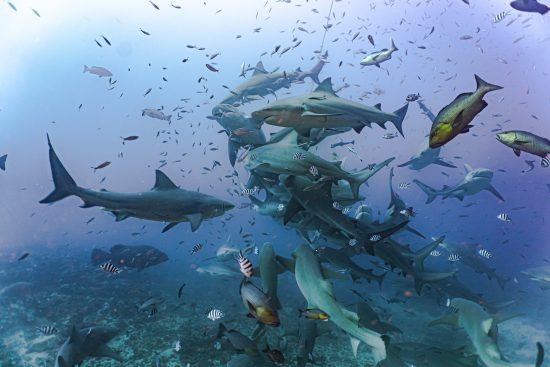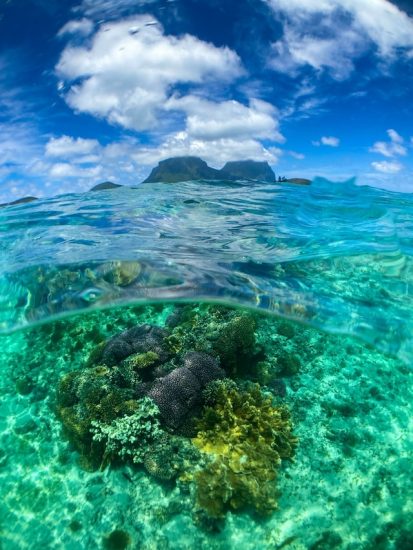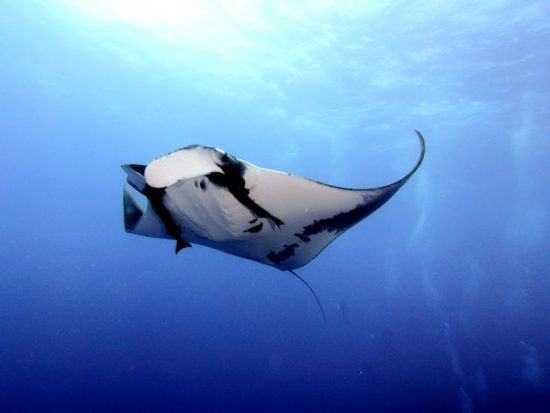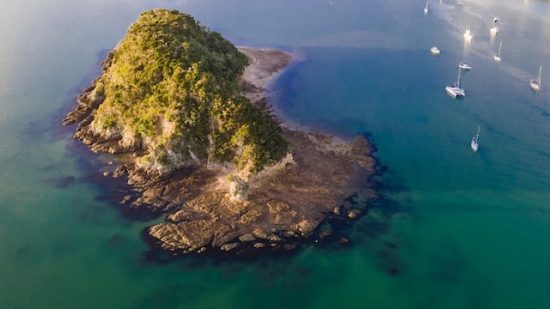








Diving in the Pacific Islands is a bucket list vacation for many scuba divers and unsurprisingly so. Idyllic islands surrounded by vibrant corals and marine life of all sizes await, with more than enough sunshine and clear, blue waters to keep any diver happy. Imagine the thrill of island hopping as you dive, discovering new worlds beneath the surface every day. The allure of diving in the Pacific is hard to beat. In this article, we’ll guide you through some of the Pacific’s most captivating islands, including some classics and lesser-known gems. Whether you're a seasoned diver or a novice, these islands offer something for you.
1. Fiji
Fiji is a coral wonderland, with crystal-clear waters and a kaleidoscope of coral gardens that feature healthy hard corals and rainbow-hued soft corals. The reefs are teeming with vibrant fish and fascinating critters as well, whilst the blue hosts a variety of sharks, plus mantas, whales, and dolphins.
The aptly named Great White Wall, an awe-inspiring wall covered in white soft corals, is a sought-after highlight of Fiji scuba diving, showcasing Fiji's rich biodiversity. The Yasawa Islands are the place to go for mantas and don’t miss Beqa Lagoon on Viti Levu for diving with bull sharks.
On non-diving days, you can unwind on Fiji’s many pristine beaches, partake in traditional Fijian ceremonies, or explore lush rainforests for a holistic island experience.
- Visit between May and October for clear blue waters and big fish encounters.
- Water temperatures range from 23°C to 28°C (73°F to 82°F).
- Fiji welcomes divers of all skill levels and Fiji’s shallow reefs have plenty for snorkelers as well.
2. Lord Howe Island
Lord Howe Island is a hidden gem tucked away in the Tasman Sea between Australia and New Zealand and is a haven for divers seeking tranquillity and unique marine encounters. It has a UNESCO-listed lagoon that boasts an underwater topography of caves, arches, and vibrant coral gardens. And thanks to being washed by various warm currents, the island’s waters are teeming with both sub-tropical and temperate marine life.
There are over 60 dive sites at Lord Howe Island and the iconic Ball's Pyramid is a must for experienced divers. This sea stack is a little over an hour by boat from the island and offers challenging yet rewarding drift, wall, and cave diving. The waters around the sea stack are bright blue, with thriving coral walls and massive schools of reef and pelagic fish.
Prepare to encounter endemic species both above and below the waterline if you visit this special island. With just 400 visitors allowed on Lord Howe Island at any one time, you’ll be diving far from any crowds there.
Make sure you leave time between diving to explore the island's diverse landscapes, hike the lush trails, and indulge at Lord Howe Island’s diverse restaurants and cafes.
- Visit from October to May for optimal dive conditions.
- Water temperatures range from 18°C to 25°C (64°F to 77°F).
- Diving at Lord Howe Island caters to all skill levels.
3. Marshall Islands
For history enthusiasts and avid wreck divers, the Marshall Islands offer an unparalleled experience. Kwajalein Atoll is a dive spot you’ve likely never heard of, where World War II relics rest alongside thriving coral gardens in crystal-clear waters.
Kwajalein Atoll is one of the world’s largest atolls, sits within a shark sanctuary, and boasts thriving reefs and plunging walls that drop hundreds of meters, plus a lagoon with numerous American and Japanese wrecks.
For experienced tech divers, Bikini Atoll is a bucket list destination. This UNESCO World Heritage Site has phenomenal deep wrecks such as the USS Saratoga, HIJMS Nagato, and USS Lamson.
During non-diving days, immerse yourself in Marshallese culture, indulge in some simple beach days, or take a land tour to experience the Marshall Island’s military instalments.
- The Marshall Islands’ main dive season runs from May to October.
- Water temperatures range from 27°C to 30°C (80°F to 86°F).
- Diving in the Marshall Islands caters to all divers, though we recommend becoming a Wreck Diver before you visit.
4. Poor Knights Islands
New Zealand's Poor Knights Islands are an unmissable dive spot if you want to witness first-hand just how successful marine reserves can be. These islands in sub-tropical Northland, just off the coast of Tutukaka, boast a dazzling array of underwater life and landscapes.
The Poor Knights Islands are washed by warm currents swept south from the Coral Sea and host numerous subtropical and temperate species. Swim through arches, tunnels, and swaying kelp forests to encounter fat, colorful nudibranchs, numerous stingrays, and huge schools of fish. Sites like Blue Maomao Arch and the world’s largest sea cave, Rikoriko Cave, provide unforgettable experiences.
On land, head north to explore the stunning Bay of Islands. Hop across the coast to meet Tāne Mahuta, an awe-inspiring (and enormous) kauri tree known as the “God of the Forest”, or head south for the city buzz of Auckland.
- Visit between December and May for warm waters full of life, though the diving is great year-round.
- Water temperatures range from 15°C to 22°C (59°F to 72°F).
- The diving is suitable for all experience levels and there are plenty of options for snorkelers as well.
5. Solomon Islands
Venture off the beaten path to the Solomon Islands, where unspoiled reefs and cultural treasures await beneath the surface. From colorful coral gardens to intricate WWII wrecks, the underwater diversity of the Solomon Islands is unmatched.
Explore highlights like Leru Cut, an underwater crevasse that cuts through an island, or Marovo Lagoon, the world’s largest saltwater lagoon. This huge lagoon covers 700 square kilometers and boasts a double barrier reef and hundreds of jungle-clad islands.
On land, embrace the unique culture, visit traditional villages, and indulge in local cuisine to enhance your Solomon Islands experience.
- Visit the Solomon Islands from April to November for clear waters and dry days.
- Water temperatures range 28°C to 30°C (82°F to 86°F).
- The Solomon Islands cater to all skill levels. We recommend getting your wreck and deep diving certifications to make the most of the Solomon Islands’ wrecks.
6. Vanuatu
Vanuatu's volcanic landscapes extend beyond its shores, creating underwater landscapes that captivate divers. Descend into the azure depths to discover underwater caves, tunnels, wrecks, and vibrant coral formations.
The SS President Coolidge wreck is a must-see for advanced divers. This enormous wreck is almost 200 meters long and 25 meters wide. It is easily accessible as a shore dive and has dozens of dive sites to explore. The famous Million Dollar Point is an exciting junkyard of shipwrecks in shallow waters, whilst Little Bay at Espiritu Santo and the Maskelyne Islands host gorgeous reefs and dugongs.
On land, visit an active volcano, swim at Champagne Beach (one of the world’s most beautiful beaches), explore among ancient rainforest trees, and take a dip in Vanuatu’s clear freshwater swimming holes.
- The best time to visit Vanuatu is from April to October.
- Water temperatures range from 24°C to 30°C (75°F to 86°F).
- Vanuatu’s dive sites cater to all experience levels.
7. French Polynesia
French Polynesia, synonymous with overwater bungalows and turquoise lagoons, offers a world-class diving experience in the lap of luxury. Dive into the depths of Rangiroa's Tiputa Pass, where you’ll encounter sharks, dolphins, and rays, and don’t miss Fakarava Atoll. It is one of the world’s best dive spots and the second largest atoll in French Polynesia, known for its thrilling currents and numerous sharks.
For a gentle yet life-changing experience, visit Moorea to go snorkeling with humpback whales. On land, you can enjoy French Polynesia's iconic resorts, indulge in spa treatments, and witness breathtaking sunsets over the Pacific.
- Visit from July to October for the dry season and humpback whales.
- The water temperature ranges from 26°C to 29°C (79°F to 84°F).
- While some dive sites cater to advanced divers comfortable in currents, there are also options for novices.
Sitting in the vast expanse of the Pacific, each of these destinations has a unique character waiting to be explored. Whether you seek vibrant coral gardens, WWII wrecks, or charismatic marine species, the Pacific has plenty of destinations to choose from. So where will you go first?
Kathryn Curzon, a shark conservationist and dive travel writer for SSI (Scuba Schools International), wrote this article.
 Kathryn
Kathryn 27th March 2024
27th March 2024